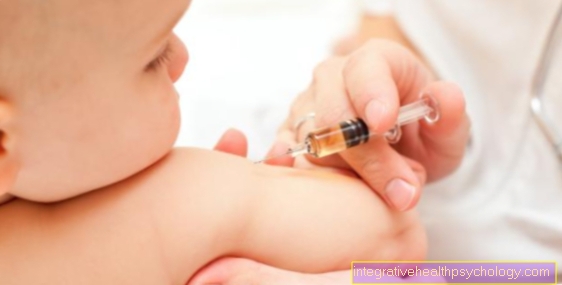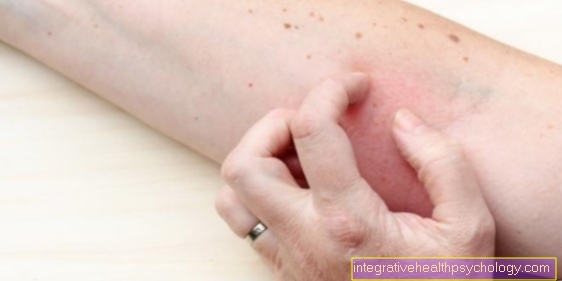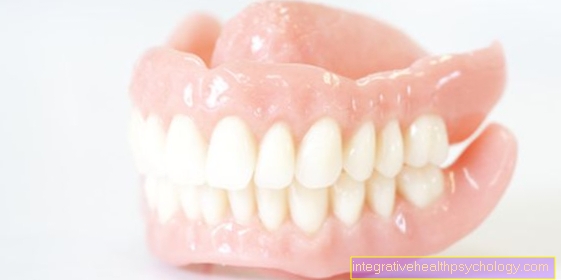Acute necrotizing ulcerative gingivitis (ANUG)
definition
In the acute necrotizing ulcerative gingivitis (ANUG) the gums are very red and swollen. Tissue decay occurs very early on (Necrosis). The inflammation often causes severe pain, which makes it difficult to eat and makes adequate oral hygiene impossible.
As the inflammation spreads further, the disease often turns into acute necrotizing ulcerative periodontitis (ANUP). Especially at the beginning of the disease, there is often poor well-being and fever.
Read also: Acute necrotizing ulcerative periodontal disease
.jpg)
Causes of ANUG
Acute necrotizing ulcerative gingivitis (ANUG) is a mixed infection of different bacterial strains, including Fusobacteria strains, Treponema and Selenomonas strains. However, the presence of certain risk factors is largely responsible for the development of this disease:
- poor oral hygiene
- Nicotine consumption
- psychological stress
- nutritional deficiency symptoms
- weakened immune system, for example in HIV-positive patients
In the case of perfect oral hygiene, the pathogens would not be able to spread as far and thus one deprives them of the possibility of destroying the tissue. This is why it is so important that the teeth are cleaned thoroughly - bacteria also like to romp around in the spaces between the teeth.
Find out more about the topic here: Oral hygiene
These symptoms could indicate ANUG
The disease is often sudden and can be accompanied by a fever. At the beginning of the disease, the gums swell, bleeding gums and acute pain can occur.
Read also: Pain associated with inflammation of the gums
Even in the early stages, necrosis occurs, i.e. tissue death, and this is characteristic punched out appearance of the gingival papillae. In addition, ulcers form on the gumline, which can appear grayish. Often you can also find yellowish deposits on the oral mucosa, which can be traced back to poor oral hygiene. Usually it comes to a putrid or metallic taste in the mouth and bad breath. General medical practice can also lead to inflamed lymph nodes and a general feeling of illness.
Diagnosis of an ANUG
Due to the rapid progression of the inflammation, early treatment by the dentist is advisable. A clinical examination of the oral cavity can often make a clear diagnosis. In addition, a laboratory examination can be helpful in order to enable targeted drug treatment. The different bacterial strains can be determined in the laboratory test.
Since acute necrotizing ulcerative gingivitis often occurs in connection with general medical diseases, you should also be examined by an internist. A transfer is helpful here.
Treatment of an ANUG
Due to the pain, oral hygiene at home is very limited, so you should use a soft toothbrush to clean your teeth. Early treatment by the dentist is important. Once the diagnosis has been made, the doctor will remove the inflamed tissue with a hand scaler, curette or ultrasound instrument. Subsequent rinsing with saline or chlorhexidine can have a supportive effect.
Chlorhexidine reduces the germ load and can also be used at home. However, care should be taken not to rinse excessively and not to use chlorhexidine for more than a week at a time, as it can lead to taste disorders and Discoloration teeth and tongue, which can, however, be removed again as part of a professional teeth cleaning
Find out more about mouthwash here: Chlorhexidine
Since acute necrotizing ulcerative gingivitis is a bacterial infection, taking an antibiotic (e.g. Amoxicillin® or Erythromycin®) can help to quickly relieve the acute symptoms. Painkillers (e.g. Ibuprofen®) can also help with severe pain.
Other supportive measures include improved oral hygiene and the avoidance of additional stimuli such as Smoke, sharp or hot food and drinks.
In addition, you should be examined by an internist, as the acute necrotizing ulcerative gingivitis could also indicate general medical diseases and infections such as HIV. Antipyretic drugs can be administered to counter the initial fever.
Duration and prognosis of the ANUG
After treatment by the dentist and removal of the inflammatory tissue, there is in most cases a clear improvement after 24 to 48 hours. Thorough oral hygiene and regular rinsing can shorten the healing process and have a positive effect. Nevertheless, the time it takes for acute necrotizing ulcerative gingivitis to heal completely varies from patient to patient and also depends on the severity of the disease and the patient's general health.
Recommendations from our editorial team
- Gingivitis
- Aggressive periodontal disease
- Causes of Periodontal Disease
- Inflammation of the gums with pus
- Swollen gums











.jpg)

-mit-skoliose.jpg)
.jpg)














